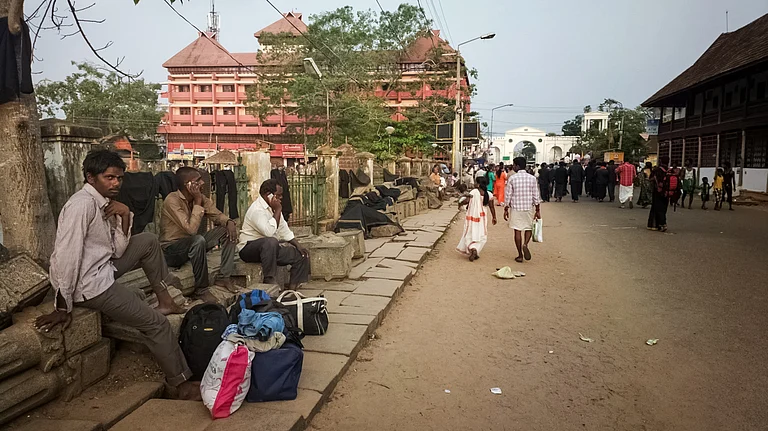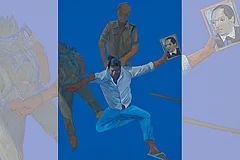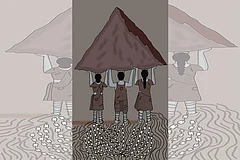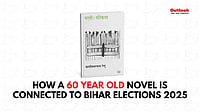I'm a filmmaker, and I am exceptionally liberated—I don’t stick to a medium or a format to manifest my ideas. Let’s take Virtual Bharat, my on-going 1,000-film journey to showcase an India never-seen, never heard before. It’s the free India that looks ordinary but leads an extraordinary life. At heart, we’re narrating stories, but the format is new. Every artist should be free to follow the path that an idea chooses to manifest itself with.
Freedom? How do I relate to it? And to the word, ‘creativity’? It all rolls back to a conversation that my dad, V Ganapathy, had with me, many years ago. It was late 1990s. I was in my early 30s. My dad asked me, ‘‘Can you create an idea that can inspire a generation?’’ Till that time, my only exposure was advertising. Everything I knew was narrated in 30 seconds. That conversation with my dad opened doors for change. I wanted to embrace an idea, and not so much the form...my mind was free.
Who knew that a conversation with my father would birth Maa Tujhe Salaam—Vande Mataram? One of the first questions in my mind was how should I express it, manifest it? I wanted to find a way to identify with the idea. I reached out to an artist, a friend, Thota Tharani. I asked him, “How does the flag instil energy and fervour into someone young who sees it?” He created a six-foot painting of the flag which had a new expression, energy, vitality, and fervour.
The umbrella idea opened up a canvas. As a filmmaker and an advertising professional, I needed that one hook, that emotionally-stirring packshot that could resonate. Honestly, I couldn’t think of a better packshot than our tricolour. I got a huge flag made, and filmed it at the best studio in London in slow motion (1000-frames-per-second). It looks magnificent to everyone who sees it even today.
Breaking Norms and Barriers
In the fiftieth year of independence, in a room cradling ideas, you definitely want to tell stories of India. We decided to make 200 one-minute films about India—its people, artists, poets, freedom fighters, and folk music—that could resonate emotionally and fill us with pride. There was no fixed format in sight, and that freedom helped create Maa Tujhe Salaam—Vande Mataram with my friend A R Rahman. An idea is not big—you build it, brick by brick.
Maa Tujhe Salaam is an idea for the people, by the people; it took a different line of thinking to make it visible and to ingrain its emotional core in people’s hearts and minds.
We chose to find our own rhythm with this. We carpet-bombed the song for 100 days. The song played on every channel at an interval of ten minutes. You could switch channels or hop cinema halls, but you could not escape Vande Mataram. Or the one-minute films that played alongside. It grew on people’s minds and hearts. For me, creativity can acquire any form, at any given time. People are happy to embrace a new idea or a style of storytelling which is honest.
In 2010, I was put in charge as the creative director for the Commonwealth Games that India was hosting. Right before I got down to business, I observed the 2008 Beijing Olympics, which was nothing short of a spectacle. It was helmed by filmmaker Zhang Yimou, someone I looked up to. Inspired, I took it on me to make the opening and closing ceremonies of the Commonwealth Games a true celebration of India, soaked in its folk, indigenous, and classical arts. We designed a large-scaled concept.
For me, it’s about the idea through which you can connect with an audience and tell them a story. Each artist uses a medium. Back in the day, when we decided to make 200 one-minute films, we had a choice to simply make a film for the cool MTV generation. But I chose to go with Doordarshan and the one-minute films because I wanted common Indians to have that MTV experience. Merely being creative is not enough. What you present should be universal in its approach and woven with simplicity. The Maa Tujhe Salaam film was lapped up by urban youngsters, and the rural people who featured in it with great pride. It bridged people using emotions that are common to them. We’re talking diversity here, without even uttering the word. Two generations have emerged since we made Maa Tujhe Salaam. But even today, when India registers an achievement or wins a World Cup, the nation does a victory lap, singing Maa Tujhe Salaam. Breaking formulas and moulds does have its pluses.
Creativity with Purpose
I don’t think I’ve inherited my father’s thoughts or his creativity; I’ve embraced his ideals. For example, he wanted me to serve people. My father, a photo journalist, would often show me his compelling and empathetic photo features. I think it was the humility of that generation that made them a certain way. My dad could have also become a celebrated man like many in his generation. He once told me, “I did it all because that was the need of the hour.” I embraced this thought. I imbibed the art of observation from him. Dad didn’t believe in exploiting art and manifesting it through the ego. I have imbibed this, too. Neither did he, nor do I work with the intention of winning accolades. Creativity flows naturally. Give me a boring, or a difficult subject and I will find something in it and make it interesting.
I respect ideas and creativity, which make room for people to be together, and build hope and courage in them. What is the purpose of creativity otherwise? When I make content, I don’t aim to change someone’s life, but momentarily, if I can make them feel good, it’s enough for me. It matters to me how we manifest an idea and make some impact with it. I filmed the Siachen Glacier for the national anthem. It was tough to go that far. I didn’t even know where the Siachen Glacier was, but I knew it’s the highest battlefield in the world. And there, soldiers stand shoulder to shoulder, protecting the nation. So my thought was that the national anthem should play out from the hearts of these soldiers, while the world watches, and feels what these men feel as they perform the highest duty towards the nation. A visual like that instils confidence that there is at least one man out there to take care of all of us.
Today, do I feel restricted as a filmmaker? Are my ideas or their execution restricted? I think, I am totally liberated, no matter what the circumstances are. I don’t politicise an idea. I operate on its merit. Vande Mataram, Jana Gana Mana or Virtual Bharat are self-commissioned projects. A key aspect of freedom is that it comes with responsibility. And we exercise both, together, at all times. Doing good doesn’t need formats; it needs people with good intentions and ideas. You give people a greater purpose, and they will all fall in line. That is the magic of creativity.
As a man of creative-thinking and free will, I might fail, but I will not stop trying and arriving at the next big idea, like my next film with Virtual Bharat. Even if every film in this project does not become popular, I feel proud that each film is artistically superior, serves a purpose and depicts a story that impacts. The bottom line is that you need to connect with humanity; for that medium, form and technicalities don’t really count. If you are connected with them, you can engage and catalyse change. I think freedom resides in you and me. You can actually find it by exercising it. There’s no freedom if you don’t exercise your WILL...responsibly.
(Views expressed are personal)
MORE FROM THIS ISSUE
Bharatbala is a Chennai-born filmmaker who tells Indian stories with a universal sensibility
(This appeared in the print as 'The Ways Of Seeing')






























